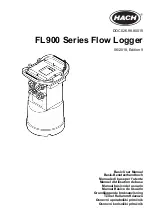
3-2
IM XL100C-E
Handshaking Method
When using the RS-232 interface for transferring data, it is necessary for equipment on
both sides to agree on a set of rules to ensure the proper transfer of data. The set of
rules is called handshaking. Because there are various handshaking methods that can
be used between the XL100 and the PC, you must make sure that the same method is
chosen by both the XL100 and the PC.
You can choose any of the three methods on the XL100 in the table below.
Data Sending Control
(Control used when sending data to a PC)
Data Receiving Control
(Control used when receiving data from a PC)
Software
Handshaking
Software
Handshaking
Table of Handshaking Methods (Yes indicates that it is supported)
O F F
X O N / X O F F
C S / R S
Handshaking
Stops
transmission
when X-OFF is
received.
Resume when
X-ON is received.
Stops sending when
CS (CTS) is false.
Resumes when it
is true.
No
handshaking
No
handshaking
Sends X-OFF
when the receive
data buffer is 3/4
full. Sends X-ON
when the receive
data buffer is
1/4th full.
Sets RS (RTS) to False
when the receive data
buffer is 3/4 full. Sets
RS (RTS) to True when
the receive data buffer
becomes 1/4 full.
Hardware
Handshaking
Hardware
Handshaking
• OFF
• Data transmission control
There is no handshaking between the XL100 and the PC. The “X-OFF” and “X-ON”
signals received from the PC are treated as data, and the CS signal is ignored.
• Data reception control
There is no handshaking between the XL100 and the PC. When the received buffer
becomes full, all of the data that overflows are discarded.
RS = True (fixed).
• XON/XOFF
• Data transmission control
Software handshaking is performed between the XL100 and the PC. When an “X-
OFF” code is received while sending data to the PC, the XL100 stops the data
transmission. When the XL100 receives the next “X-ON” code, the XL100 resumes
the data transmission. The CS signal received from the PC is ignored.
• Data reception control
Software handshaking is performed between the XL100 and the PC. When the free
area of the received buffer decreases to 1537 bytes, the XL100 sends an “X-OFF”
code. When the free area increases to 511 bytes, the XL100 sends an “X-ON”
code.
RS = True (fixed).
• CS/RS
• Data transmission control
Hardware handshaking is performed between the XL100 and the PC. When the CS
signal becomes False while sending data to the PC, the XL100 stops the data
transmission. When the CS signal becomes True, the XL100 resumes the data
transmission. The “X-OFF” and “X-ON” signals received from the PC are treated as
data.
• Data reception control
Hardware handshaking is performed between the XL100 and the PC. When the
free area of the received buffer decreases to 1537 bytes, the XL100 sets
“RS=False.” When the free area increases to 511 bytes, the XL100 sets
“RS=True.”
3.1 RS-232 Interface Specifications and Setup Procedure
















































